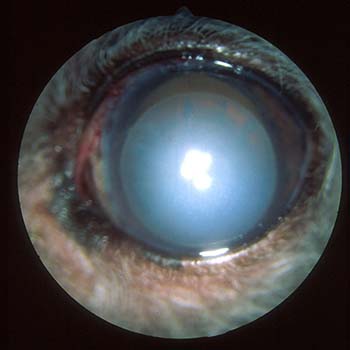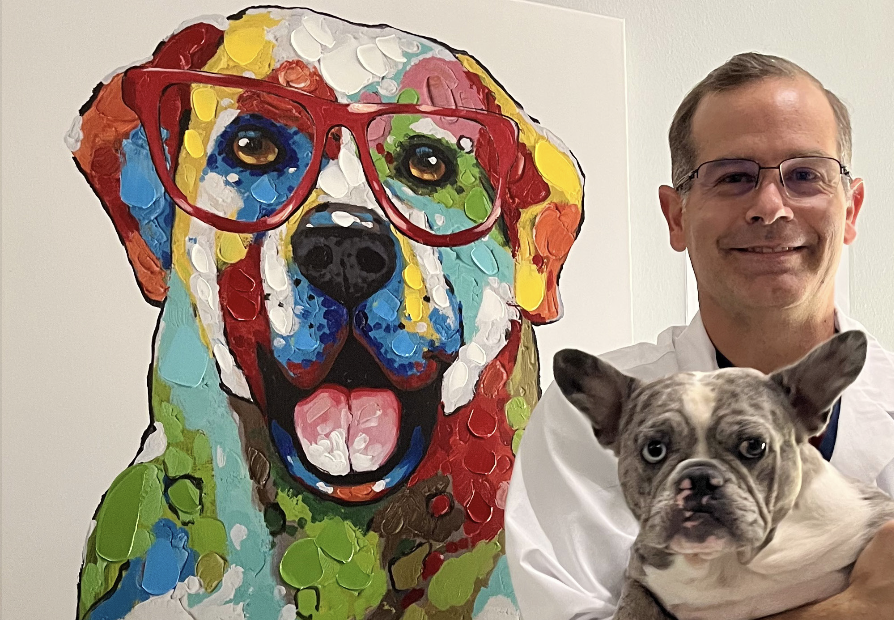Pet Lens Luxation in Katy, TX
Pet lens luxation is a serious eye condition that occurs when the lens within the eye becomes unstable or dislocated. At Animal Eye Medical & Surgical Specialists in Katy, TX, we offer expert care to diagnose, treat, and manage lens luxation, helping to preserve your pet’s vision and comfort.
What Is Pet Lens Luxation?
Lens luxation occurs when the small fibers, known as zonules, that hold the lens in place behind the pupil weaken or break down. This instability can lead to the lens shifting out of its normal position. Lens luxation can be classified into three types:
Subluxation
Partial breakdown of the zonules, causing the lens to become loose but still in its correct position.
Posterior Luxation
Complete breakdown of the zonules, with the lens moving behind the iris.
Anterior Luxation
Complete breakdown of the zonules, with the lens moving in front of the iris. This condition is considered an emergency.
Causes of Pet Lens Luxation
Several factors can lead to lens luxation in pets, including:
- Genetics: Certain breeds, such as Terriers, Miniature Poodles, and Cocker Spaniels, are more prone to developing lens luxation due to inherited traits.
- Intraocular Inflammation: Inflammation inside the eye can weaken the zonules, leading to lens instability.
- Advanced Cataracts: As cataracts progress, they can contribute to the breakdown of zonules.
- Trauma: Injuries to the eye can cause the lens to dislocate.
- Age-Related Changes: Aging can lead to the gradual weakening of the zonules, increasing the risk of lens luxation.

Why Pet Lens Luxation Is a Serious Condition
Lens luxation is closely associated with the development of glaucoma, a painful and potentially blinding condition. Anterior lens luxation is especially critical, leading to glaucoma in up to 73% of affected dogs. Immediate treatment is essential to prevent permanent vision loss.
If you suspect your pet may be suffering from lens luxation, it is crucial to seek veterinary care without delay. Call us immediately at 832-437-0119 to protect your pet’s vision and well-being.
Treatment for Pet Lens Luxation
The treatment for lens luxation depends on the type and severity of the condition:
Anterior Lens Luxation
This requires urgent surgical intervention to remove the lens and prevent the onset of glaucoma. The surgery involves making a large incision in the cornea to extract the dislocated lens.
Posterior Luxation and Subluxation
These can often be managed with topical medications that constrict the pupil and reduce intraocular inflammation. However, close monitoring is necessary to watch for signs of glaucoma.
Why Choose Animal Eye Medical & Surgical Specialists?
- Specialized Expertise: Our team is experienced in diagnosing and treating complex eye conditions in pets.
- Advanced Surgical Techniques: We offer surgical solutions tailored to preserve your pet’s vision and comfort.
- Comprehensive Care: From initial diagnosis to ongoing management, we provide compassionate and thorough care for your pet’s eye health.
- Emergency Services: We are equipped to handle urgent cases, ensuring your pet receives prompt and effective treatment.
At Animal Eye Medical & Surgical Specialists in Katy, TX, your pet’s vision and well-being are our top priorities. Our dedicated team is here to provide the specialized care needed to manage lens luxation and other eye conditions. We understand the importance of early diagnosis and timely treatment in preserving your pet’s quality of life.
If you suspect your pet may be experiencing symptoms of lens luxation, such as sudden vision changes or discomfort, contact us immediately. Early intervention is crucial to safeguarding your pet’s eye health.

